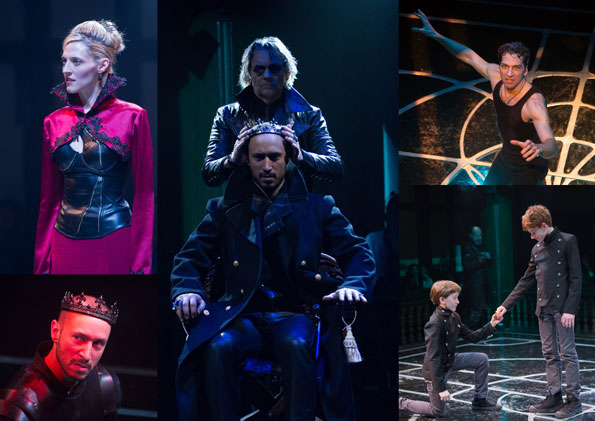REVIEW: Folger resets the stage for an intimate ‘Richard III.’

“Richard III” at Folger Shakespeare Library (From top left: Julia Motyka/Photo by Teresa Wood. Richard Sheridan Willis and Drew Cortese/Photo by Teresa Wood. Michael Sharon/Photo by Jeff Malet. Remy Brettell and Holden Brettell/Photo by Teresa Wood. Drew Cortese/Photo by Jeff Malet.)
It is hard to imagine the elegant Folger Theatre reconstructed in the round as a setting for the dark, murderous “Richard III.” It seems an unnecessary gimmick devised by director Robert Richmond and a defilement of the theater’s unique Elizabethan space. But the stage that Richmond envisioned coupled with the superb, utilitarian design of Tony Cisek and Jim Hunter’s lighting works brilliantly.
In reconfiguring the Folger, by tearing out the seats and centering the action, Richmond has created an intimate atmosphere in which the audience can feel it is part of the action. The entire theater becomes Richmond’s stage with actors appearing in the balcony and in other areas of the audience. The stage is also designed with body-sized trap doors to dispose of all the murdered players that were in the way of Richard’s ambition.
“Richard III” is one of Shakespeare’s more controversial plays and Richmond’s Richard, the especially talented Drew Cortese, dominates the stage. Even when he isn’t performing Richmond has him lurking in the shadows as he works his way to the crown. Richard could give Tony Soprano lessons and like the mob boss, for all his devious calculations, he has a sly, charming side. The way Cortese portrays the viperous king, it is surprisingly possible to like him. He is after all a politician of his time. There were no elections to vote for a king, so like an ambitious politician, he eliminates his opponents in the pragmatic road available to him in seeking high office.
Cortese is an inspired choice to play Richard. Even while affecting the limp, not the traditional hunchback of the grotesque king, Cortese glides like a dancer across the stage. With a shaved head and an intense demeanor, he understands how to play a man of intelligence and sly charm. It is worth noting that marriages in that historical period were not love unions; they were political alliances and the players understood the game. With that in mind, it is audacious to see Richard asking the mother of the young princes he has had murdered in the Tower of London for her support to marry her daughter.
Richmond has assembled a smart cast with effective performances from such actors that include Paul Morella (King Edward), Howard W. Overshown (Buckingham, Richard’s henchman) Michael Sharon (Richard’s brother Clarence) and Naomi Jacobson (the mad Queen Margaret).
The Richard at the Folger is a much a more sympathetic man than Shakespeare envisioned. Richard was the last Plantagenet king and it is good to remember that the smart, ambitious Shakespeare was writing for the reigning Tudors — the winners write history. This Richard resonates in light of the recent discovery of the bones of the defeated monarch beneath a Leicester parking lot where his body had been unceremoniously dumped into a hastily dug grave and lost for half a millennium.
History is constantly subject to interpretation and it may be that Richard wasn’t as vile as the Tudors wanted him to be. Richmond was careful not to have Cortese portray his Richard as a grotesque, sniveling hunchback, although he did apparently suffer from a curvature of the spine. The slight limp that Cortese affects is sufficient and doesn’t distract from Richard’s bloody ambition. No matter what the interpretation, we are fascinated by Richard because villains are much more interesting.
“Richard III” continues through March 16, 2014 at Folger Shakespeare Library, 201 East Capitol St. SE. Tickets $30-$72 available at 202-544-7077 and online here.
